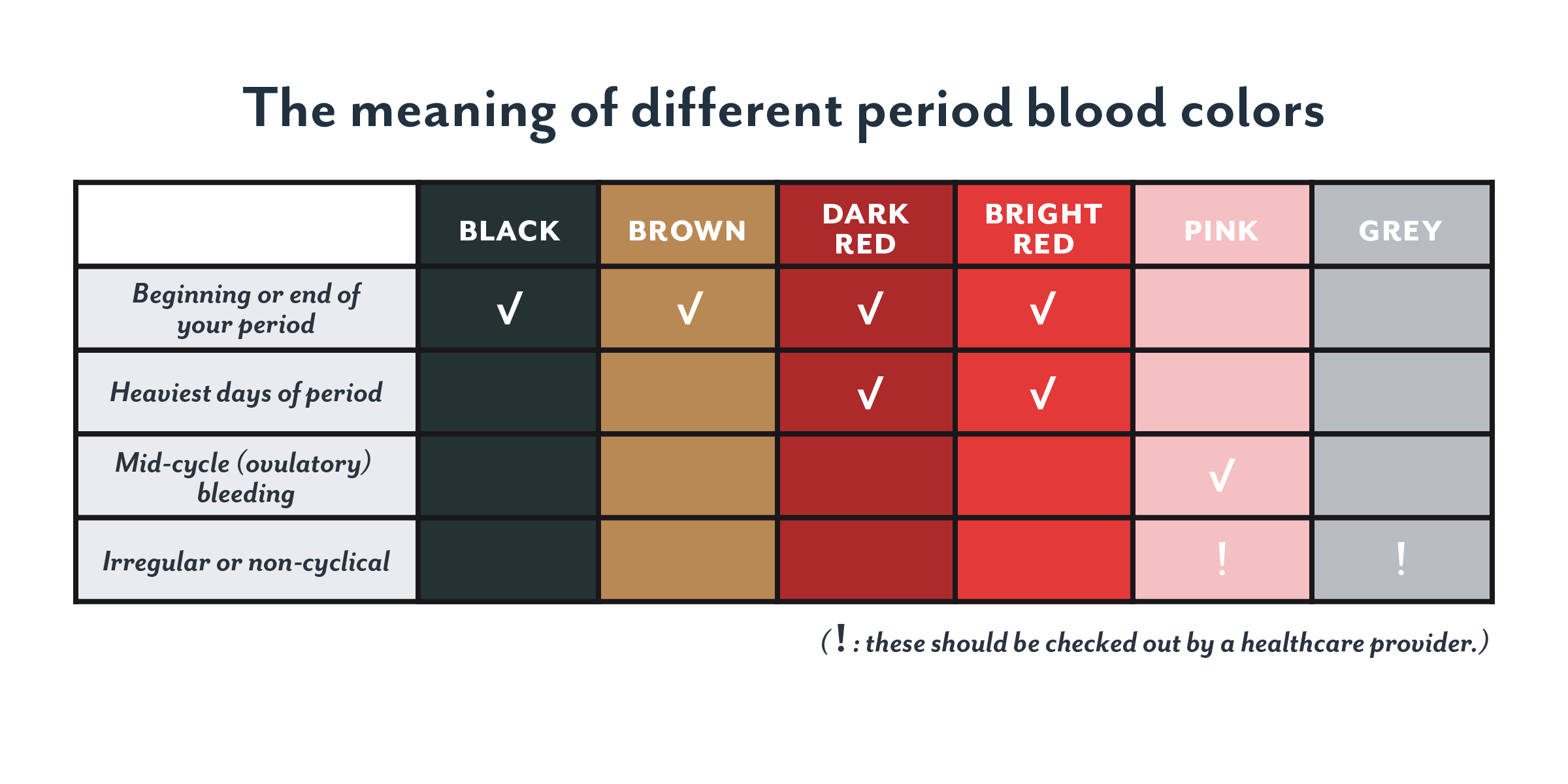For most women, menstruation begins between ages 12 and 13. You may bleed in what’s commonly called a “period” every 21 to 35 days or so.
According to the American Academy of Obstetricians and Gynecologists, your period may be used as a vital health sign. Anything from the length of your cycle to the textures and colors you see may indicate something important about your health.
You may see colors of blood ranging from black to bright red, brown to orange. Although most colors can be considered “normal” or “healthy”, others may be reason to see your doctor.
Period Blood Color Types
Period blood varies in color that are mentioned below with details
1) Black Color Period Blood
You may be alarmed to see black blood, but it isn’t necessarily a reason to worry. This color is related to brown blood, which is old blood. It may resemble coffee grounds. Black blood is usually blood that’s taking some extra time to leave the uterus.
2) Brown Color Period Blood
Brown discharge of all shades is typically a sign of old blood. The blood has had time to oxidize, which is why it’s changed from the standard red.
Brown blood is associated with:
The beginning or end of your period
When your flow is slow, the blood may take longer to exit your body. When blood stays in the uterus longer, it may become brown in color. The blood may also be left over from your last period.
Lochia
The bleeding women experience for the first four to six weeks after delivering a baby is called Lochia. It starts out relatively heavy. Then from day four onward, Lochia may be pinkish or brownish in color.
Pregnancy
If you experience spotting during pregnancy, some of it may be brown if the active bleed has stopped. It’s a good idea to call your doctor regardless.
Missed miscarriage
Although miscarriage may be associated with bright red bleeding, some women may experience what’s called a “missed miscarriage”. With this type of pregnancy loss, the fetus stops developing but doesn’t pass from the uterus for at least 4 weeks. You may not experience heavy bleeding or clots, but some women do develop dark brown spotting or bleeding.
3) Dark Red Color Period Blood
You may see dark red blood upon waking during your period or after you’ve been lying down for a while. The deep color may simply mean that the blood has been sitting in the uterus for a while but hasn’t oxidized to the point of turning brown.
Dark red blood is associated with:
The end of your period
You may also see this color blood toward the end of your normal menstrual period as your flow slows.
Lochia
The bleeding after delivering a baby starts out heavy and may contain clots. It may appear dark red in color for the first three days before changing to different shades and textures. Women who had cesarean sections may only experience this heavy bleeding for the first 24 hours.
4) Bright Red Color Period Blood
Your period may start with bright red bleeding. This means that the blood is fresh and is flowing quickly. Your blood may stay this way your whole period or may darken as your flow slows.
Red blood is associated with:
Infection
Some infections, like Chlamydia and gonorrhea, may cause bleeding between periods. If you’re seeing blood before you’re due to start your period, consider contacting your doctor.
Pregnancy
Bleeding during pregnancy of any color may or may not be reason for alarm. Sometimes, however, it’s a sign of miscarriage. Sometimes women have bleeding and go on to deliver healthy babies. Each case is unique. It’s best to check in with your doctor whenever you see blood during pregnancy.
Polyps or fibroids
These noncancerous growths in the uterus may cause heavy flow during your periods or at other times throughout the menstrual cycle. They can be large or small and cause other symptoms like pain and pressure.
5) Pink Color Period Blood
Your blood may appear pink in color at the beginning or end of your period, especially if you’re spotting. This lighter shade likely indicates that the blood has mixed with your cervical fluid, diluting its hue.
Pink blood is associated with:
Lochia
From day four onward, Lochia may be pinkish or brownish in color.
Low estrogen
Sometimes pink menstrual blood may indicate low estrogen levels in the body. Estrogen helps to stabilize the uterine lining. Without this hormone, you may shed the lining at times throughout your cycle leading to spotting of various colors, including pink. Some causes of low estrogen include being on a hormonal birth control that doesn’t contain estrogen, or perimenopause.
Mid-cycle spotting
You may see this color around ovulation time. Again, when blood from your uterus mixes with clear cervical fluid, it may appear to be light red or pink in color.
Miscarriage
If you’re pregnant, a gush of clear or pink fluid from the vagina may be a sign of miscarriage. Other signs including cramping, passage of tissue, and loss of pregnancy symptoms.
6) Orange Color Period Blood
When blood mixes with cervical fluid it may also appear orange. As a result, you may see orange discharge for the same reasons you see pink discharge.
Orange blood is associated with:
Implantation spotting
Some women report seeing orange or pink spotting around the time of suspected implantation or 10 to 14 days after conception. Not all women experience implantation spotting, but it can range in color. If you have spotting that doesn’t turn into a period, it’s a good idea to take a pregnancy test.
Infection
Any abnormally colored or unusual discharge may also be a sign of bacterial infection or sexually transmitted infection (STI).
7) Grey Color Period Blood
Seeing gray or off-white discharge is a reason to call your doctor.
Gray blood is associated with:
Infection
This hue may indicate that you have an infection brewing, like bacterial vaginosis. Other signs of infection include:
- fever
- pain
- itching
- foul odor
Miscarriage
If you’re pregnant, gray discharge may be a sign of miscarriage. Tissue passing from the vagina may be gray in color as well.
Blood Color Difference at the Beginning & End of Period
Your period may change colors from the beginning to the middle to the end. You may even have different colors from month to month or at different times throughout your life. There are a number of factors involved, even when your periods are totally “healthy.”
In most cases, the variation from bright red to dark red to brown has something to do with the flow and time the blood has been in the uterus. Your flow may be faster at the beginning of your period and trail off toward the end. You may have dark red blood after laying down for a long time, too. You may see bright red blood on your heaviest days.
This doesn’t mean that all changes in color are normal. If you see a shade that’s unfamiliar or gray especially if you have other symptoms, there’s no harm in making an appointment to get checked out. And any bleeding during pregnancy is reason to touch base with your doctor.
Period Blood Texture.
Watery Blood Periods or filled with Clots
Besides color, the texture of your blood may change throughout your period. And your periods from month to month may be different textures as well. Clots aren’t necessarily a reason for concern. They happen as your uterus sheds its lining. Size matters, though. If you see clots that are bigger than a quarter in sizes, you may want to let your doctor know. Same goes with clots that accompany heavy bleeding.
Watery period blood is thin and likely new blood flowing quickly from the uterus. Some women may experience particularly heavy flow, which is called menorrhagia. Clots may or may not accompany the bleeding with this condition. Look out for signs of anemia, like fatigue or shortness of breath.
Blood-tinged discharge that happens around the time of ovulation may be mixed with cervical mucus, giving your blood an egg white or gelatinous texture. This discharge may also be described as wet and slippery.
Checkup
You may see a variety of shades and textures with your periods, even if you’re healthy. If your period is lasting longer than seven days or is very heavy, soaking through a pad or tampon every hour or two,make an appointment with your doctor to rule out certain medical conditions.
Other reasons to make an appointment:
- if your cycles are irregular, changing dramatically in length from one month to the next
- if your cycles are shorter than 24 or longer than 38 days in length
- if you haven’t had a period in three months or longer
- if you have considerable pain or other unusual symptoms that accompany your bleeding
- if you bleed between periods
- if you’ve gone through menopause and start bleeding again
If you’re pregnant, talk to doctor about any bleeding you see. Spotting or bleeding may be a sign of miscarriage. Gray discharge may also indicate miscarriage or even infection, so it’s best to get it checked out, too.



